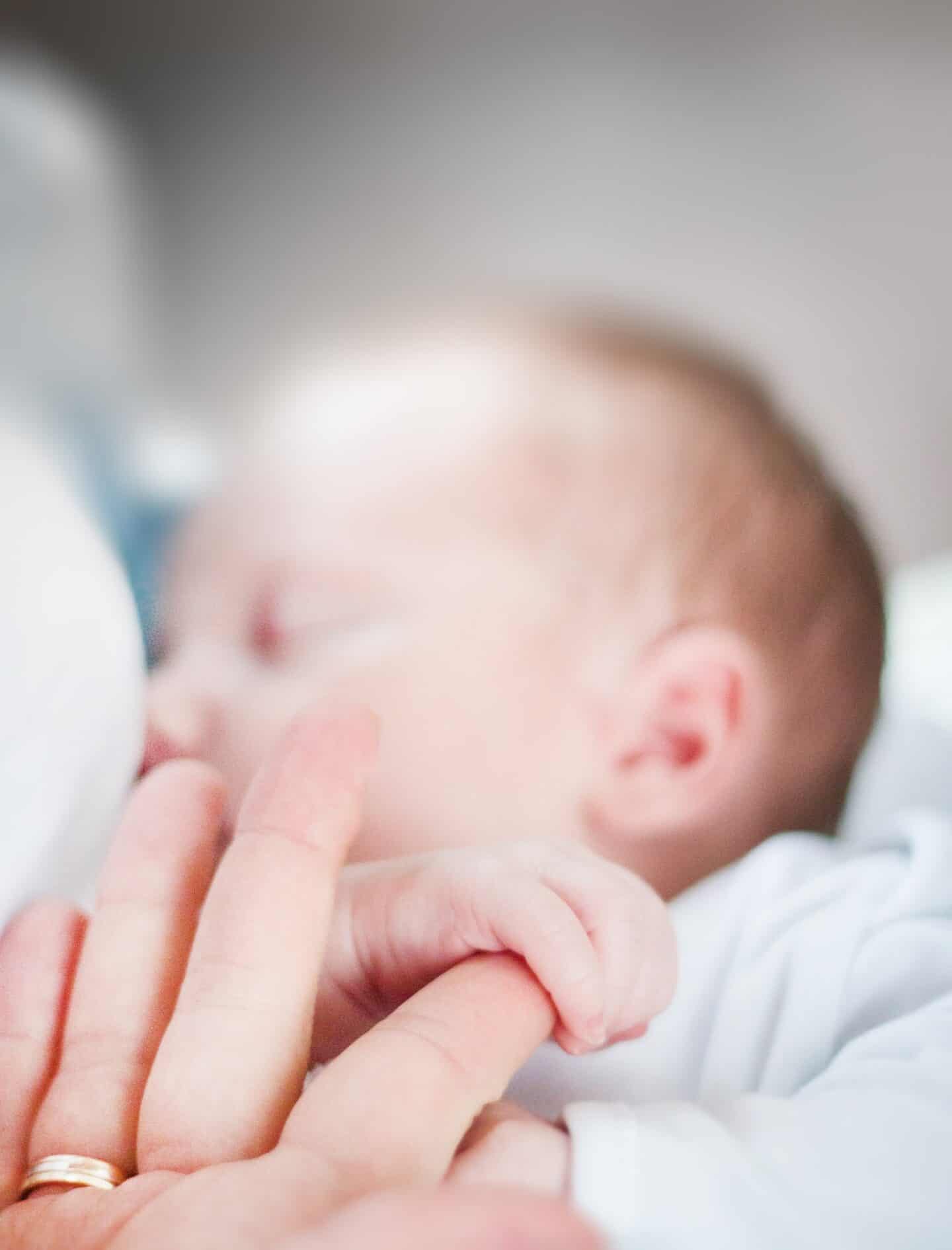Do you have blood in your freshly expressed breastmilk?
Do you have cracked and bleeding nipples?
Are you dealing with blood in breastmilk after clearing a clogged milk duct?
Is there blood in your breastmilk once every month?
Blood anywhere on your body is always worrying, let alone looking down and noticing that the breast milk you’re pumping is red or pink due to your own blood.
Logically you’ll immediately freak out and wonder whether it’s safe to keep breastfeeding with bleeding nipples.
Or question what could have caused your nipples to bleed when pumping.

First of all, take a deep breath!
You’re not the only nor the first mom to have gone through this worrying situation.
I’m writing this post to put your mind at ease, as you know, I’m a mom of 5 kids and I’ve breastfed all of my babies so I have had this experience more than once.
In this post, I’ll be giving tips on how to heal your damaged nipples and what you should do if you see blood in your breastmilk when you are exclusively pumping.

The Underlying Issues
In the first place, you really need to do is find the main cause of the problem. Why are your nipples bleeding in the first place?
Once you’ve identified it, you’ll be able to work on how to fix it, so you can avoid any additional problems.
For the most part, you should focus on healing once the cause -and treatment- has been identified.
There’re a few likely reasons for bleeding and cracked nipples when pumping. I’ve listed some of them below.
RELATED: ARE YOU MAKING THESE PUMPING MISTAKES?
Breast Shield Size
If it’s your first-time pumping or even your second, you might want to check if you’re using the wrong size shield.
It can be difficult to work around due to the fact you can’t exactly try and buy one at a store, so it’s all about guesswork.
Find The Right Size
One of the main problems for nipple pain is the flange being too big or too small. Your nipple might rub too much against the sides if it’s too small.
If it’s too big, a large amount of your areola is pulled into the breast shield which can lead to soreness.
It’s not easy to determine which breast shield is the right size for you.
Measuring your nipple or buying a bunch of different sizes to try on and find which one is the most comfortable might be an option for you.
But it all depends on what you feel is the right thing to do and what you’re most comfortable with.
This article looks at how you can measure correctly to try and get the right fit for you. Unfortunately, you may end up spending some money on trial and error but once you get the right fit you can be sure it will have a positive impact on getting the milk flowing.
RELATED: HOW TO PUMP WHILE BREASTFEEDING
The Key Is To Be Comfortable
I remember trying to measure my nipple, it was quite difficult.
Of course, it’s not the easiest job in the world because most of us not know where to measure to and from.
But buying a ton of different sizes means spending money just try them and that’s just not a smart move in my book.
Nipple Positioning
You need to ensure that your nipple is positioned correctly in the breast shield otherwise it will be pulled into the tunnel the wrong way, causing an injury.
There is such a thing as a Lactalite which will help you see your nipple positioning (even in low light) and help prevent any of these issues.
Pump Speed
Make sure that your pump is at the right speed for you. Even if you’re struggling with low milk supply and trying to get more milk, you shouldn’t exceed the speed you find most comfortable.
It’s better to go slow and avoid any let-down which can be inhibited by pumping with pain.
Mastitis
It comes with redness, swelling, possible chills, and fever. This is a common breast infection.
If you don’t feed or pump often enough you might be more susceptible, but you won’t need to take medication or anything to clear it up.
Breast Cancer
This is scary and also very rare, so try not to worry yourself too much over it.
If the bleeding and discharge from your nipples continue, you should check with your personal doctor.
Although extremely odd, there’re a few forms of cancer that can cause bleeding in the milk ducts.
Again, you would need to be seen by a medical professional if this is something you’re worried about.
The Best Way To Heal Bleeding Nipples
You might have some pain while the damage heals, especially when you manage to figure out what the root cause is.
You’ll lose milk supply if you stop pumping, which is unfortunate but important if you want to nurse your baby.
I have listed a few home remedies to help you with your cracked nipples which you may find useful.
Before pumping
- Don’t be afraid to take a pain reliever like Motrin or Tylenol. These are both compatible with breastfeeding and can help with the pain you’ll be feeling.
- Use a washcloth which is warm to help relieve nipple pain.
While pumping
- Pump the one side that is the least damage because nipple pain tends to be worse before your let-down. Once you’ve done the one side and the milk supply lessens, pump the other side too.
After pumping
- Use a warm compress again for the pain after you’ve finished pumping.
- Your nipples might heal more quickly if you use a saline rinse.
- Ensure that your nipples and areola are dry by using a cloth to gently pat them dry.
- If you apply Lanolin after pumping, it might speed up the healing process.
- If you’re wearing breast pads, be mindful to change them frequently because constant moisture can prolong the healing process.
- You can find inserts for your bras which protects the nipples if you find that wearing anything like a bra or tight clothes causes discomfort. Most inserts have holes in to allow the air to get in so your nipples can heal.
RELATED: HOW TO INCREASE BREASTMILK IN A ‘SLACKER BOOB’.
Can I Still Breastfeed If My Nipples Are Bleeding?
Scientists say that it is completely safe for a baby to continue having milk even if it has a bit of the mother’ blood.
Your baby might spit up due to it upsetting its tummy, which isn’t nice for anyone, but it doesn’t do it any harm.

I continued to feed my babies even when my breast milk had a bit of blood.
I wanted my baby to continue to have the nutrients, even if it was only slightly due to the small amount they’d bring up. Being a mom gives you the intuition on what is best, whether that is continuing to pump or not, you’re in control.
RELATED: IS MY BABY GETTING ENOUGH BREAST MILK?
It’s Your Decision
Panicking when we see our blood is an automatic response, that’s normal. But honestly, even the smallest amount of blood can turn the entire bottle of milk into a pink or light red color.
Blood in breastmilk is actually a common issue.
Although, if you’re worried about the amount of blood present, then it’s completely fine to put the breaks on breastfeeding.
It isn’t for everyone and if you’re too worried about it, then please consult with your doctor or health advisor.
They will be able to give you the right advice or point you in the right direction for your needs.
Red Flag: Serratia marsescens
Also, please remember there is a bacteria known as Serratia marsescens.
It can turn your milk pink or red, so be sure the reddish color you’re seeing in your breastmilk its actually blood.
Why Is This Bacteria Present In The First Place?
It can happen due to leaving pump parts out overnight without washing and then using them normally.
The problem with this type of bacteria is that it can be dangerous for your baby.
So, if you’re not entirely sure if its blood, or want some peace of mind then get it checked out.
It might even be a case of you not being able to identify the injury or you might not feel any pain.
Speak to your paediatrician.
How Can You Store Blood-Tinged Milk?
There isn’t really any need to dump any pumped milk just because there is a bit of blood in it.
Don’t forget, you wouldn’t even notice it if you were breastfeeding instead of pumping.
RELATED: STORING, FREEZING AND THAWING BREAST MILK IN THE CORRECT WAY
When To Call The Doctor
If you are really worried and keep seeing a lot of blood, then it’s time to call the pros.
It’s always best to be safe than sorry.
In my case, I was very worried I was getting on the doctor’s nerves because, at the time, I was the type of parent that would be on the phone at my child first sneeze, to make sure they had the right care from the get-go.
Honestly? It’s their job to be there for you and your children so if you are worried about it in any way, then don’t hesitate to contact them.
However, if the amount of blood is insignificant and nothing else is going on that’s concerns you, wait a few days to see if it clears up on its own.
Most of the times, it does.
Although, if it doesn’t or you have other issues on top of it, you may want to double-check everything is okay.
Talk To Your Lactation Professional If You Need To
You might want to speak to a lactation professional if you have cracked, sore or dry skin on your nipples.
They will be able to help you identify why this was caused and what you can do to prevent it in the future.
You most likely won’t need to make a special call to your doctor if you’re only seeing blood on occasions. If you are worried get checked out and put your mind at ease.
Although you might want to bring this issue up in your baby next check-up. Then, you’ll be able to mention it, your doctor will take note of it and, if necessary, the baby can be checked as well.
It’s Okay To Seek Help And Reassurance
We all worry sometimes and feel we need a bit of reassurance from the doctor, which is completely fine and rather normal.
If you feel you need that, not just for you but for your baby as well, then, by all means, ask away!
YOU MAY ALSO LIKE THE BEST ONLINE BREASTPUMPING CLASS EVER!
REFERENCES
Walker, Breastfeeding Management for the Clinician, 2017
